
Gryllus bimaculatus is one of many cricket species known as field crickets. Also known as the African or Mediterranean field cricket or as the two-spotted cricket, it can be discriminated from other Gryllus species by the two dot-like marks on the base of its wings.
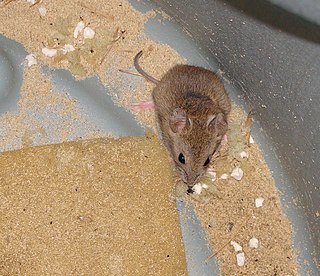
Vesper mice are rodents belonging to a genus Calomys. They are widely distributed in South America. Some species are notable as the vectors of Argentinian hemorrhagic fever and Bolivian hemorrhagic fever.
Platymantis bimaculatus is a species of frog in the family Ceratobatrachidae. It is endemic to West Papua, Indonesia.
Rhacophorus bimaculatus is a frog species in the moss frog family (Rhacophoridae). Described by Wilhelm Peters in 1867, it is endemic to the Philippines. There, it is known to occur on the islands of Bohol, Mindanao, and in the south of Luzon; it might also be found on other islands as its known range brackets the main chain of the Philippines archipelago.

The orange-spotted bulbul is a species of songbird in the bulbul family of passerine birds. It is endemic to Java, Bali and Sumatra.

The African jewelfish, also known as jewel cichlid or jewelfish, is from the family Cichlidae.
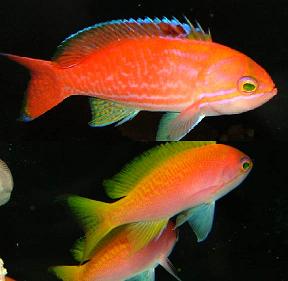
Pseudanthias bimaculatus is a tropical fish with the common names two-spot basslet, twospot or twinspot anthias and bimac anthias. It is lesser known as the purple goldie.

Ecsenius bimaculatus, known commonly as the twinspot coralblenny, is a species of marine fish in the family Blenniidae.
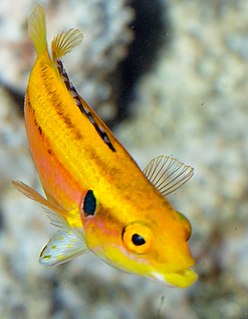
The twospot hogfish, Bodianus bimaculatus, is a species of wrasse native to the Indo-Pacific from Madagascar to New Caledonia and from Japan to New Zealand. This species prefers areas of reefs with substrates of rubble or sand at depths from 30 to 60 m. This species can reach a length of 10 cm (3.9 in). It can be found in the aquarium trade.

Anolis bimaculatus, the panther anole, also known as the St. Eustatius anole, is a species of anole lizard that is endemic to the Caribbean Lesser Antilles. It is found on the St. Kitts Bank of islands, which comprise Saint Kitts, Nevis, and Sint Eustatius.

The two-spotted bumble bee is a species of social bumble bee found in the eastern half of the United States and the adjacent south-eastern part of Canada. In older literature this bee is often referred to as Bremus bimaculatus, Bremus being a synonym for Bombus. The bee's common name comes from the two yellow spots on its abdomen. Unlike many of the other species of bee in the genus Bombus,B. bimaculatus is not on the decline, but instead is very stable. They are abundant pollinators that forage at a variety of plants.
Lepidonectes bimaculatus, known commonly as the twinspot triplefin, is a species of triplefin blenny in the genus Lepidonectes. It was described by Gerald R. Allen and David Ross Robertson in 1992. This species is found in the eastern Pacific Ocean where it has been recorded only in the vicinity of Malpelo Island in Colombia. The twinspot triplefin acts as a cleaner fish, its only client species being the grouper Epinephelus labriformis.
Phrissomini is a tribe of longhorn beetles of the Lamiinae subfamily. It was described by Thomson in 1860.
Parabrimus is a genus of longhorn beetles of the subfamily Lamiinae, containing the following species:

Ompok bimaculatus, known as butter catfish, is a species of sheatfishes native to Asian countries such as Bangladesh, India, Pakistan, and Sri Lanka, but recently identified in Myanmar.
Nudiviridae is a family of viruses, the nudiviruses. Insects and marine crustaceans serve as natural hosts. There are currently three species in this family, divided among 2 genera. Diseases associated with this family include: death in larvae, chronic disease in adults.
Parabrimus alboscutellatus is a species of beetle in the family Cerambycidae. It was described by Stephan von Breuning in 1936.
Parabrimus ruficornis is a species of beetle in the family Cerambycidae. It was described by Breuning in 1981.
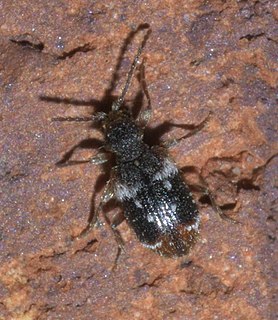
Ptinus bimaculatus is a species of spider beetle in the family Ptinidae. It is found in North America.
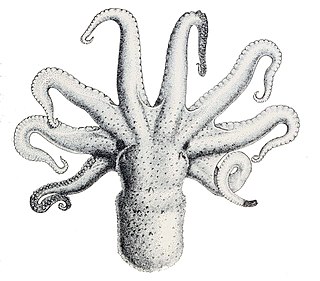
Octopus bimaculatus, commonly referred to as Verill's two-spot octopus, is a similar species to the Octopous bimaculoides, a species it is often mistaken for. The two can be distinguished by the difference in the blue and black chain-like pattern of the ocelli. O. bimaculatus hunt and feed on a diverse number of benthic organism that also reside off the coast of Southern California. Once the octopus reaches sexual maturity, it shortly dies after mating, which is approximately 12–18 months after hatching. Embryonic development tends to be rapid due to this short lifespan of these organisms.













